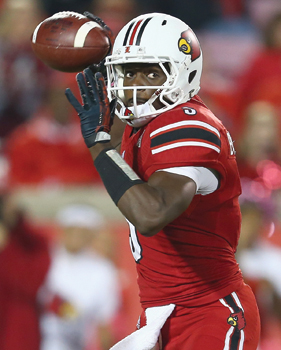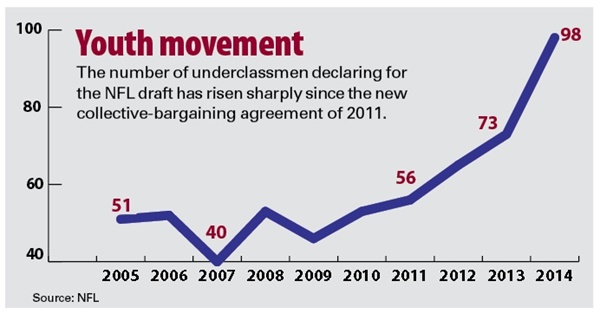The number of college underclassmen declaring for the NFL draft is up 75 percent in the last three years, a trend that troubles some in the industry.
“I think the two words I would use to describe the amount of juniors coming out early this year are ‘surprising’ and ‘disappointing,’” said Rich McKay, Atlanta Falcons president and CEO and the chairman of the NFL Competition Committee.
 |
Louisville’s Teddy Bridgewater rates high on the board, but other underclassmen do not.
Photo by: GETTY IMAGES
|
The NFL announced last week that a record 98 underclassmen had applied for and were granted special eligibility for the draft, up from last year’s record of 73. The NFL provides college underclassmen who apply with an evaluation of whether they are likely to be drafted and, if so, where in the seven-round draft, but the NFL does not release that information publicly.
“Our College Advisory Committee has worked extremely well in giving potential entrants a very accurate prediction of where they may be drafted,” McKay wrote in an email response. “Hopefully, this will be a one-year anomaly.”
The number of underclassmen declaring early for the draft has been steadily rising since 2011, when the league and the NFL Players Association agreed to a new collective-bargaining agreement that reduced the amount of money by about half that first-round picks could receive. Agents say that for prospective NFL players, more than ever, their financial future is about getting to the second contract, rather than staying in school to improve their draft status.
Gil Brandt, former head of player personnel for the Dallas Cowboys, now writes for NFL.com and advises the NFL on which players to invite to the draft. He said that if agents advised some of the underclassmen on the list to come out early, they did them a disservice.
“There are guys on there I don’t think have much of a future as far as pro football is concerned,” Brandt said, though he declined to name names.
Todd McShay, NFL draft analyst for ESPN, remembers that for years, the number of underclassmen declaring for the draft held at about 50 (see chart). “We added a full round of players,” McShay said of the increase. Without supplemental picks, there are 32 players selected in each round of the draft, to be held in May in New York City.
Of the 73 underclassmen who declared for the 2013 draft, 53 were drafted. McShay estimated that of the 98 players who declared early for the draft this year, about one-third would be drafted in the late rounds or wouldn’t be drafted at all.
“I think it’s a negative trend, and something has got to change,” McShay said.
The larger number of underclassmen declaring for the draft is a potential problem for NFL teams, said a former general manager who did not wish to speak about team business publicly because he may return to the league. Underclassmen “are typically underscouted and there are more mistakes made with them than with the four-year players.”
McShay agrees. “Scouts don’t have enough to evaluate them,” he said.
Another factor that may have pushed more juniors into the draft is the NFLPA’s 2012 repeal of the so-called Junior Rule. That rule prohibited contact between NFLPA-certified agents and underclassmen, and though many colleges and universities kept a tight lid on agent contact with student athletes this year, more juniors declared for the draft.
Jack Mula, a partner in Cornerstone Sports Consulting, which provides education and agent search services to players at about a dozen universities, wondered whether the influx of players seeking jobs in the NFL might indicate a need for a developmental league.
Mula, who has been both an NFL agent and a club general counsel, said there are many potential reasons for the increase, including the NFL success stories of players who were drafted in the latter part of the draft, such as Julian Edelman and Richard Sherman, and those who went undrafted, like Wes Welker and Tony Romo.
“Is it indicative of the additional number of college football programs that are started each year?” Mula wrote in an email. “Or is it, as so many critics are quick to point out, the results of bad advice from bad people?”





